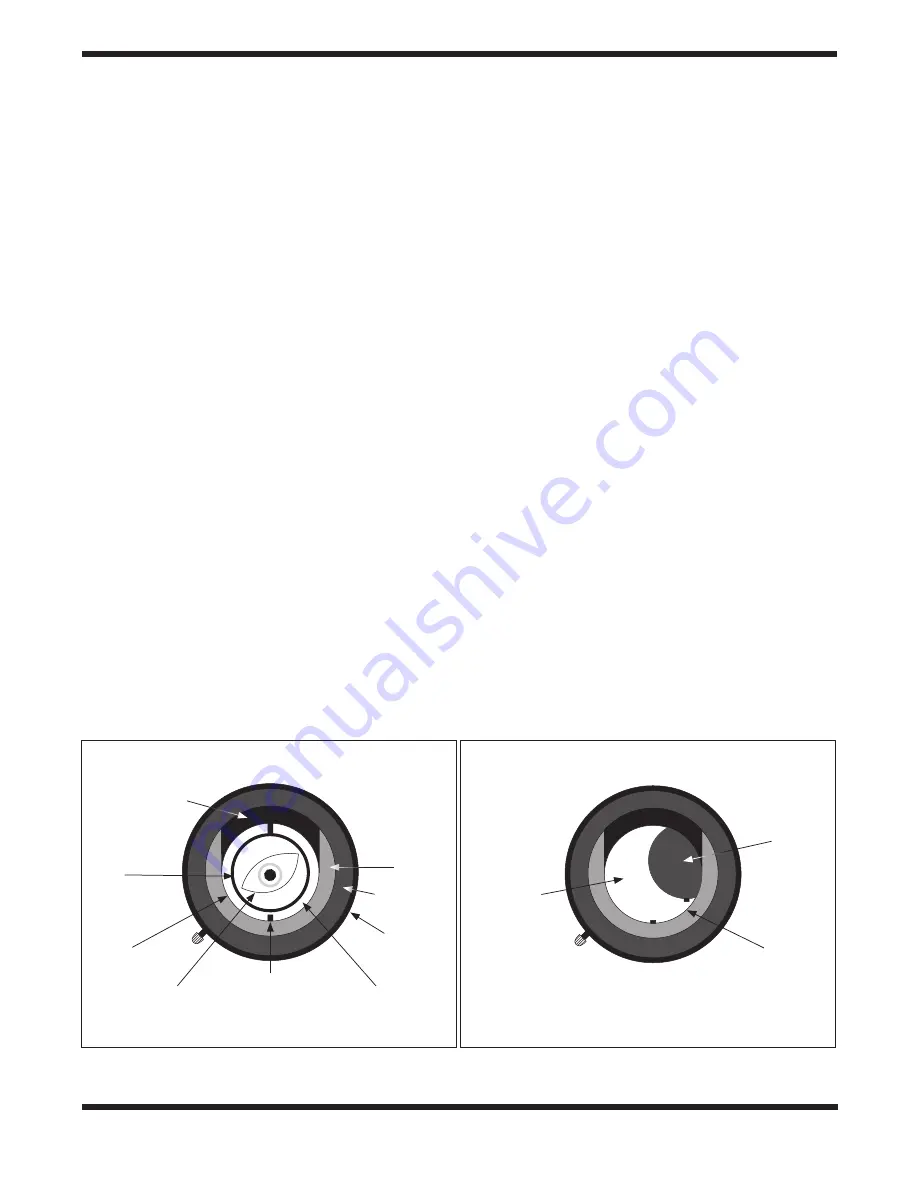
13
Figure 14.
Collimating the optics.
A.
When the mirrors are properly aligned, the view down the focuser should look something like this.
B
Here, the secondary mirror is centered under the focuser, but it needs to be tilted so that the entire primary mirror is visible
Appendix A
Collimation – Aligning the Optics
Collimation is the process of aligning the telescope’s optics.
For the StarMax 90 Maksutov-Casegain telescope, the optics
were aligned at the factory and should not need any further
adjustment by the user. Reflector telescopes, on the other
hand, do require occasional collimation adjustment by the
user, because the two mirrors that make up the optical system
can become slightly misaligned during transport of the tele-
scope, or due to temperature changes. Although the optics of
the SkyScanner 100 Reflector were aligned at the factory, it is
possible that the mirrors became misaligned in transit.
Accurate collimation is important to ensure the best images
from your telescope. Collimation is a relatively easy process
and can be done in daylight or darkness. To check the col-
limation, remove the eyepiece and look down the focuser
drawtube. You should see the secondary mirror centered in
the drawtube, as well as the reflection of the primary mirror
centered in the secondary mirror, and the reflection of the sec-
ondary mirror (and your eye) centered in the reflection of the
primary mirror, as in
Figure 14A
. If the entire primary mirror
reflection is not visible in the secondary mirror, as in
Figure
14B
, you will need to adjust the tilt of the secondary mirror
with the three setscrews surrounding the center screw (
Figure
15
). Using the included 2mm Allen wrench, first loosen one of
the three alignment setscrews by, say, a half turn, and then
tighten the other two to take up the slack. Is the primary mir-
ror reflection more centered in the secondary mirror now? You
may need to loosen a different screw then tighten the other
two to better center the primary mirror in the secondary. It’s
a matter of trial and error. The goal is to center the primary
mirror reflection in the secondary mirror, as in
Figure 14A
, by
adjusting these three screws in this fashion. Do not adjust the
center screw.
The primary mirror of the SkyScanner 100 Reflector is fixed in
place, so it is not adjustable.
The view down the focuser drawtube should now resemble
Figure 14A
. A simple star test will indicate how well the tele-
scope optics are collimated.
Star-Testing the Telescope
When it is dark, point the telescope at a bright star and accu-
rately center it in the eyepiece’s field of view. Slowly de-focus
the image with the focusing knob. If the telescope is correct-
ly collimated, the expanding disk should be a perfect circle
(
Figure 16
). If the image is unsymmetrical, the scope is out
of collimation. The dark shadow cast by the secondary mirror
should appear in the very center of the out-of-focus circle, like
the hole in a donut. If the “hole” appears off-center, the tele-
scope is out of collimation.
If you try the star test and the bright star you have selected is
not accurately centered in the eyepiece, the optics will always
appear out of collimation, even though they may be perfectly
aligned. It is critical to keep the star centered, so over time you
may need to make slight corrections to the telescope’s posi-
tion in order to keep the star in the center of the field of view.
A good star to point at for a star test is Polaris, the North Star,
because its position does not move significantly over time.
Reflection of
secondary mir-
ror
Reflection of
your eye
Retaining
tab
Reflection
of primary
mirror
Eyepiece
holder
Drawtube
(inside)
Telescope
Wall
Edge of
secondary
mirror
Secondary mirror
holder
A
B
Reflection of
secondary
mirror
Reflection
of primary
mirror
Edge of
secondary mirror
















